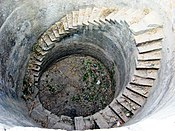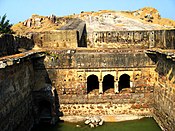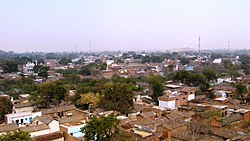|
Kulpahar
Kulpahar is a city in Mahoba district in the Indian state of Uttar Pradesh. It is a historical town in the Bundelkhand region. Before 11 Feb 1995 Kulpahar was a Tehsil of Hamirpur District.[1] On 11 Feb 1995 Mahoba District[2] was carved out of Hamirpur, and Kulpahar is now a part of the Mahoba District. Kulpahar is the largest Subdivision of Uttar Pradesh. Kulpahar is known for its closeness to Khajuraho and other historic places like Mahoba, Charkhari, Kalinjar Rath, Orchha, and Jhansi. This town holds relics of temples and man-made water bodies of the Chandela Dynasty Origin of the nameHistorians have different theories about the origin of its name, primarily there are two opinions about the name. i. Two village theory - According to the Imperial gazetteer of United Province of Agra and Oudh -1909 there were two different villages Kulhua and paharia which later jointly became the town of Kulpahar; even the folklore says the same. It doesn't have any supporting evidence for the theory; it seems that the British writer of the gazetteer went by the folklore. ii. Second theory[3] is based on some historical facts dating back early 17th century. There was a cult gossain[4] in the central India and one of the descendant of the followers of this cult Himmat Bahadur Gossain[5] who actively took part in Indian freedom struggle was born in Kulpahar and Kulpahar had connection with this cult since the origin of the cult. Gossain cult is believed to be originated/started from Kulpahar. Historians who relate Kulpahar with the gossain cult gave the theory that Kulpahar word is composed of two words Kula and pahar means Clan mountain. Some relate it with a tantrik rite Kaula Tantra. Kulpahar was a site to perform secret tantrik rituals of gossain cult on a hill near Gahra lake; hence the town got its name Kaula pahar which as the time passed became Kulpahar. HistoryKulpahar was the capital of a princely state of the same name in British India. Kulpahar was founded in 1700 by Raja Jagat Raj[6] of Jaitpur, son of Maharaja Chhatrasal, and was reorganized by Senapati, a Bundela Rajput who was Raja Jagat Raj's son. Kulpahar was captured by the British in 1804, and became a princely state in the Bundelkhand Agency of the Central India Agency. The chief resided at the town of Nowgong in Madhya Pradesh. The fort of Kulpahar, situated on a steep hill, towers more than 800 ft (244 m) above the sea level, and contains the ruins of elaborately carved sculptures. Brief history of Kulpahar is covered under the section of origin. Not much information is available about the medieval and ancient history of Kulpahar but the remains of structures dating back 9th and 10th century confirm the existence and importance of Kulpahar in the ancient and medieval India. After the Mughals' fall and the rise of Chhatrasal Bundela, Kulpahar passed under his sway but failed to acquire any kind of pre-eminence. In the 17th century, Chhatrasal declared independence and put a stiff resistance against Aurangzeb. He established a Bundella Principality and Bahadur Shah Moghal had to confirm all his acquisitions in the area called 'Bundelkhand'. There was a revival of hostilities during the reign of Farrukhsiyar when his general Mohammed Khan Bangash invaded Bundelkhand in the year 1729 and the aged ruler Chatrasal had to seek aid from Peshwa Baji Rao. His 'Maratha'army of 70,000 men dashed from Indore (Malwa) and encamped at Mahoba. They surrounded forces of Nawab Bangash who had captured Jaitpur, Belatal, Mudhari and Kulpahar etc. The Peshwa inflicted a crushing defeat over the Nawab by annihilating his forces in the dense forests of Jaitpur, Mudhari and Salat near Kulpahar. In return for this help, Chhatrasal bequeathed one third of his dominion to the Maratha chieftain. That part included Mahoba, Shri Nagar, Jaitpur, Kulpahar etc. Later, under the treaty Bessien in 1803 the marathas ceded Bundelkhand area to British rulers. Its administration was, however, carried over by the subedar of Jalaun until 1858 when it was finally annexed by the East India Company. Kulpahar was made the headquarters of a Tehsil under the sub-division of Mahoba in the district of Hamirpur. Archaeological sitesThere are quite a few archaeological sites in and near Kulpahar from the 10th century.[7] Some of the sites are:  
GeographyKulpahar is on National Highway No. 76, 135 km from Jhansi and 278 km from Allahabad at an altitude of 795 feet (242 m) at Latitude 25° 19' N, Longitude 79° 39' E. AdministrationLocal self governmentKulpahar is governed by a municipality under the Uttar Pradesh Municipal Act. It has 17 member council and the council is chaired by a chairperson who is directly elected by 15,145 electorates. The council is called Nagar panchayat Police administration Kulpahar city's security is maintained by Kulpahar Kotwali. An officer of the cadre of Deputy Superintendent of Police heads the police administration of Kulpahar. Kulpahar Kotwali is headed by Kotwal an officer of Inspector cadre. Kulpahar police circle consists of 4 police stations namely
Water supplyDrinking water supply of the city is managed by Chitrakoot Jalkal Sansthaan's Jaitpur subdivision under Banda division. Water is supplied from a big reservoir Belasagar through lift irrigation to Raja Ka Tal where the Chitrakoot Jalkal Sansthaan has a water filter plant with a capacity of 15,000,000 litre per day. Fairs and festivalsAll the major Indian festivals are celebrated here. The longest of them is festival of Navratra and Dussera. It is a 10-day-long festival and idols of goddess Durga are placed in many places and day-night long celebrations continues. The festival ends with the immersion of the idols in bara tal lake. Other major festivals are Holi, Diwali, Eid, Christmas and Raksha bandhan. In the month of August and September the Jalvihar fair is organized in the city. It is month-long celebration. during the opening day of fair idols of all the temples of town are taken out of the temple and a procession takes place. CuisineTypical north Indian food is served and taken everywhere in the town. But a typical bundeli cuisine called "bhata aur gakariya" is very popular here. It is a curry of brinjal and a specially cooked bread. EducationDegree colleges
Vocational and polytechnic
Intermediate education schools
Junior schools
Primary schools
HospitalsGovernment hospitals
Banks and treasursiesNational banks
Other banks
Treasuries
Climate
Passenger transportationAirKulpahar is served by the Khajuraho airport (90 km) and is linked to Delhi and Varanasi by Indian Airlines. Other airports in the vicinity are Kanpur (180 km) and Lucknow (250 km). RoadNational Highway 76[10] runs through the center of the city. Kulpahar is located in between Jhansi and Allahabad on this highway. Another highway that links Kulpahar is National Highway 86 starts at Kanpur and ends at Sagar in Madhya Pradesh. There are other highways that link Kulpahar to other parts of the state. Kulpahar also has one bus station and a railway station catering to different routes. Regular bus services are available to nearby towns like Mahoba, Banda, Nowgaon, Charkhari, Rath, Orai, Chitrakoot, Karwi, Hamirpur and Kulpahar is also well connected with bus services to Allahabad, Varanasi, Kanpur, Lucknow, Delhi, Agra, Jhansi, Jaipur and Ajmer. Tourist taxis, auto-rickshaws and tempos are available for local transport. But the cheapest and most efficient method of local transport is the Tonga. Rates are not fixed and one needs to bargain. RailKulpahar is a railway station[11] of the North Central Railways Zone, and is well connected by trains with all major cities, namely, Kolkata, Delhi, Mumbai, Jhansi, Varanasi, Agra, Gwalior, Khajuraho, Udaipur, Jaipur, Jabalpur, Gaya, Mathura and Allahabad.  Major Trains connecting Kulpahar with rest of the country are 11107/11108 Bundelkhand Exp, 12175/12176 Gwalior-Howrah Chambal Exp, 12177/12178 Mathura-Howrah Chambal Exp, 12189/12190 Mahakoshal Exp, 11069/11070 Tulsi Exp and 12447/12448 Uttar Pradesh Sampark Kranti Exp, 19665/19666 Intercity Exp, 22447/22448 Khajuraho Link Exp. Granite mining in Kulpahar Kulpahar region comprises areas which are essentially covered by grey, pink, red granitic rock and black dolerite. The rocks are generally medium to coarse to very coarse grained, having variegated colours with varying textural patterns. In geological nomenclature they can be classified on the basis of colour, grain size and texture. Over half of the areas identified so far appear suitable for extracting blocks of two cubic meters in size from the surface outcrops. The granite with red feldspar having presence of white and bluish quartz has become popular in national and international markets during the last 10 years.[citation needed][when?] The remaining outcrops would be suited for blocks of smaller size. Ruby red granite is good in quality and is popular in national and international markets.[citation needed] In granitic terrain the rocks may occur in the form of widespread sheets exposed above the ground level, in the form of hillocks, as high ground or below the ground under soil cover. They may also occur as boulders of different size and shapes spread over the sheet rock. They may be found as dykes, particularly of black and green types, as long narrow ridges often concealed beneath the surface. A major part of granite deposits in these regions are underground and have to be extracted by open cast mining. Underground granite block is more compact and require sophisticated and specialised machinery which adds to the cost of mining. ExcursionsHistorical
Natural
Religious
Museum
DemographicsReligion in Kulpahar (2011) Hinduism (85.04%) Islam (13.72%) Christianity (1.09%) Buddhism (0.01%) Jainism (0.01%) Not Stated (0.11%)
As of 2011[update] India census,[15] Kulpahar had a population of 20,096. Males constitute 52.6% of the population and females 47.4%. Kulpahar has an average literacy rate of 75.8%, higher than the national average of 74.1% with male literacy rate of 84.8% and female literacy rate of 65.8%. In Kulpahar, 12.9% of the population is under 6 years of age.[16] 
References
External links
Wikimedia Commons has media related to Kulpahar. |
||||||||||||||||||||||||||||||||||||||||||||||||||||||


